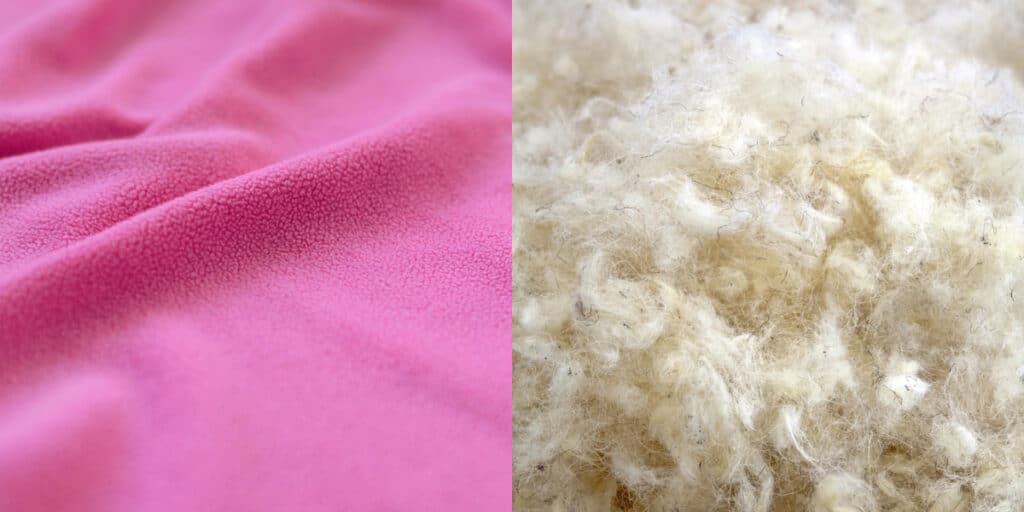What we now call fleece in modern clothing is a relatively new invention from Patagonia in the 1960s. Is it possible for this new clothing material to be better than sheep’s wool?

Fleece and wool are similar in insulation properties, however, fleece garments dry faster than similar wool garments. Furthermore, synthetic fleece garments are cheaper than wool garments of the same type, although there are more environmental concerns for fleece since most fleece garments have synthetic materials which rub off into microplastics as a byproduct of laundering.
Fleece vs. Wool
I’m going to compare fleece and wool based on how warm the two fabrics are as well as other factors that might help you decide between the two.
By the way, as an Amazon Associate, I earn when buying qualified products through links on my site.
Overall, fleece and wool garments can be made in such a way to keep you warm. If you choose one or the other you won’t be disappointed with whether they keep you warm or not.
The only substantial difference from a warmth perspective between fleece and wool is in drying time which I talk about later.
Is Fleece the Same As Wool?
Now, before I jump into the comparisons, you might be wondering what the difference is between fleece and wool. This is what’s confusing… 100 years ago, fleece and wool meant very similar things.
A fleece, in general, is just a warm coat of something. Wool is wiry hair that grows on some animals, but we primarily get it from our sheep. So, you could say that a coat of wool on a sheep is a fleece.
In fact, the 1828 Webster’s dictionary has this to say:
Fleece: The coat of wool shorn from a sheep at one time.
1828 Webster’s Dictionary
However, in the 1970s, the company Patagonia experimented with a synthetic fleece meant to copy the warmth of wool (source). Thus, fleece was used to describe this new fabric preparation technique where the fabric is “brushed” using equipment which essentially makes the fibers more bushy and thus have better insulation.
You can see fleece in the making here:
So, fleece often nowadays refers to fabric that has been brushed in this or similar techniques to produce fabric that has been expanded to have better insulation. Modern fleece can be made of natural materials such as cotton, but often is made from polyester or other plastic substances (sometimes used plastic soda bottles).
So now, if you look up the word fleece, you might see something like this:
Fleece: a soft warm fabric with a texture similar to sheep’s wool, used as a lining material.
google
Is Fleece Warmer Than Wool?
So manufactured fleece (synthetic or otherwise) is this wonder material, supposedly–but is it as warm as wool?
I had no idea what I was getting myself into when I tried to find the answer to this question. It turns out “warmth” is a much more complicated concept than I thought.
Fleece and wool garments of similar textures and thicknesses provide the same warmth–So it doesn’t matter which fabric type you choose as long as you choose one that is thick enough and is brushed in a way (for fleece) to capture enough air.
Insulation of Fleece vs. Wool
Although I couldn’t find a study that directly compared wool and fleece of the same thickness for insulation, I was able to find some interesting data:
| Fabric Type | Thickness | Thermal Resistance (R value) |
|---|---|---|
| Wool 76.19%, polyester 21.67%, and elastene 2.14% (study 1) | 1.32mm | .0488 |
| Polartec 100% polyester fleece (study 2) | 1.522mm | .043 |
This research made it clear to me that whether something is made of fleece or wool doesn’t make a big difference in how warm the clothing is.
Remember, insulation has almost everything to do with how well something captures air. The more something is able to trap air, the better the insulation. This is because air doesn’t transmit heat all that well, making it a great insulator.
What this means for clothing is that the puffier and thicker the clothing is, the more air will get trapped inside and therefore the warmer you’ll be because you will keep more of your body heat.
In fact, from this study, the researchers found that the way the fabric was brushed made a noticeable difference in how warm a fleece garment was. With our new knowledge of what fleece is and how insulation works, this makes sense: whether a fleece has cotton or polyester or both makes less of a difference than if it has been through the “raising” process.
So, don’t sweat it.
Warmth Perception
I learned something crazy as I was trying to find the answer to the question: is fleece better than wool?
How warm clothes feel isn’t all about temperature!
Yeah… I had to think about one for a second as well.
According to this research paper, how warm a garment feels also depends on the fineness of the material. Rougher and courser materials feel less warm than soft and fine materials.
Not only that, but the color of the fabric itself makes a difference in how warm the fabric seems!
All that said, how warm we feel our clothes ought to be does nothing for our core body temperature, but the takeaway is that depending on how the clothes were made can impact how warm the clothes seem–so it’s even more difficult to compare fleece and wool because depending on their make they can look and feel very similar.
So, if you are deciding between a fleece and a wool jacket of similar weight and thickness–you may be better off just going with the one that looks and feels more comfortable.
That being said, there are some important differences between wool and fleece when it comes to water. Let’s check that out.
Wool vs. Fleece When Wet
Both fleece and wool lose their insulation properties when wet. The major advantage fleece has is that it dries much faster than wool.
There’s some controversy on this topic, in this study they conclude that wet wool insulates better than wet polypropylene (a plastic)–however, a blogger did his own research and found no strong difference in insulation between fleece and wool when they were wet.
However, this blogger did find that the fleece dried many times faster than the wool of around the same thickness.
This all may vary for you since it really depends on the exact manufacturing process of your clothes. From one garment to the next, the insulation when wet can change.
Because Fleece Dries Faster, Does That Make It Better?
Well, the answer isn’t exactly clear. It seems obvious that if fleece dries faster, than it’s a superior garment. However, because the water is evaporating more quickly, the wearer will lose more body heat more quickly. In the long run this works out because the fleece will dry out and the wearer will have their insulation back.
So, wool will take longer to dry but that means the wearer will lose their body heat more slowly. Once again, there isn’t a clear winner here. It may be that if you are going to be outside for a long period of time (like if you’re going to be camping) then a fleece makes sense. In other circumstances, if you’re going to be outside for a short period of time and you might get wet, then you might save more body heat by wearing wool.
In reality, we really don’t worry about these decisions. The best thing to do above all is to stay dry. A waterproof shell is really important in cold conditions if there is any remote possibility of getting wet.
When hiking or running in cold conditions, I wear my Columbia rain jacket (got it on Amazon). Combined with a warm fleece mid-layer and base layer, I can be outside for hours without issues.

If you’re interested in learning how to dress for hiking in 10 degree weather, check out my post, here.
Fleece Vs. Wool Environmental Impact
Something else that is worth talking about is the environmental impact of fleece vs. wool.
Wool Environmental Impact
Wool is an amazing fiber. It’s just mind-boggling that one of the most important textiles grows on sheep! The best part about wool is that it grows back. The sheep does not have to die to give up its amazing wool fleece. The sheep effectively turns grass into wool, which to me is more amazing than turning straw into gold.
While wool seems completely eco-friendly–it’s worth remembering that wool comes from sheep which need pastureland (and lots of it). Any cattle has its own environmental impact. Sheep output an average of 23g of methane per day per sheep (source), which is about 5-12x less than cows. Methane is a greenhouse gas and every sheep contributes, and that’s just one of the costs of keeping sheep among many.
Fleece Environmental Impact
From our discussion above, when we say fleece we mean the modern fleece which is a fabric that has been “raised” to produce a fluffy fabric that is amazing at keeping you warm.
Modern fleece often is made from polyester or other plastics, often in combination with natural fibers such as cotton. Fleece can be made from recycled plastics, which is a great thing since we probably won’t run out of spare disposed plastic anytime, soon.
However, the big concern about fleece is plastic microfiber. When fleece is washed, little tiny particles of plastic slough off into the water. These tiny particles of plastic affect downstream rivers, lakes, and even oceans and can kill aquatic life and affect overall water quality. See this study for more details.
So overall, there is no perfect solution to staying warm. Everything has a cost. It’s up to all of us to decide what choices to make.
